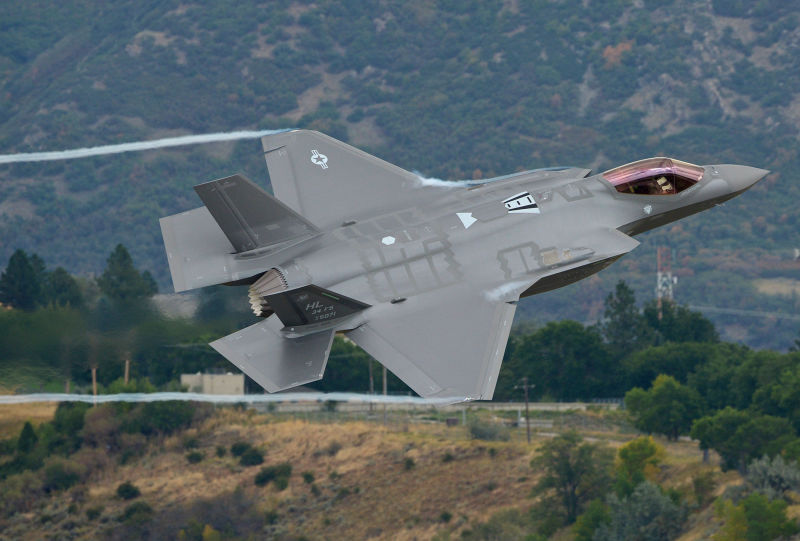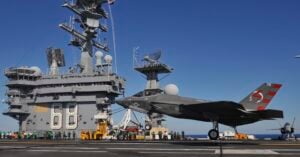
Air Force F-35A
ARLINGTON: One week after President-Elect Donald Trump tweeted that the cost of the F-35 Joint Strike Fighter was “out of control,” the F-35 program office announced the price of most variants had dropped yet again. The contract for Low Rate Initial Production (LRIP) Lot 9 will buy 57 aircraft, 34 for the US and 23 for foreign partners Britain, Norway, Italy, Japan, and Israel:
- 42 F-35As (26 US, 16 foreign), the vanilla variant used by the Air Force and most foreign partners, at $102.1 million apiece — 5.5 percent less than the previous lot, LRIP 8, and 60 percent below the first fighters bought under LRIP 1.
- 13 F-35Bs (6 US, 7 foreign), the “jump jet” variant used by the Marine Corps and the Royal Navy, the most technologically challenging model, at $131.6 million apiece — 1.8 percent below LRIP 8.
- 2 F-35Cs (both US), the US Navy variant reinforced for tooth-rattling aircraft carrier takeoffs and landings, at $132.2 million apiece — a 2.5 increase over LRIP 8, but that’s because the Navy slashed its buy in half (from 4 planes to 2), losing economies of scale.
In other words, if you want to reduce the cost per plane, you really don’t want to reduce the number you’re buying.
[Air Force F-35As likely to deploy to Europe vs. Russia in summer 2017]

Lt. Gen. Christopher Bogdan
“This program is not out of control,” said a clearly frustrated Lt. Gen. Chris Bogdan, who heads the F-35 Joint Program Office. “I would like to explain to the new administration this is a vastly different program from 2011.”
Yes, the period 2006-2011 saw a series of disasters adding up to a six-year delay and a $13.5 billion cost overrun, Bogdan acknowledged, but the program was radically restructured in 2011 (a concept that bankruptcy-prone Trump should be familiar with). “Since 2011 we have basically been on schedule. Since 2011 we have basically been on budget. We are delivering now today 50+ airplanes a year.”
“When we do settle LRIP 10,” Bogdan continued, expect all three variants “to come down in price significantly…. probably somewhere on the order of six to seven percent.” By the time the plane enters Full Rate Production in 2019, Bogdan estimates the price will be down to $80-$85 million for an F-35A, $110 million for a F-35B, and a $96 million for an F-35C. That’s comparable to the (inflation-adjusted) prices of the older aircraft they replace, aircraft that lack the F-35’s stealth, advanced electronics, and artificial intelligence software.

Marine Corps F-35B
There continue to be delays and overruns on the immensely complex program, Bogdan acknowledged, but not on a scale comparable to the pre-2011 years. Contract lots LRIP 9 and LRIP 10 are taking much longer than expeted to negotiate with contractor Lockheed Martin, with the government invoking a rarely-used contract provision to unilaterally set a price on LRIP 9. The program is reinforcing the wings and landing gear of the carrier variant, which undergoes by far the most stress; fixing a faulty wiring bracket that caused a fire in an F-35B; and replacing faulty insulation on some F-35As. The plane’s high-stakes Initial Operational Test & Evaluation will start six to nine months behind schedule, in early 2018, and Pentagon IOT&E director Michael Gilmore — famous for his independence and his withering critiques of high-priced programs — has refused to allow work-arounds to save time, Bogdan said. The delays will add about $532 million to the cost of the program, but Bogdan said $100 million of that reflected past cuts imposed by the Pentagon to pay bills elsewhere, and $165 million reflects improvements to cybersecurity and other new requirements not envisioned when the cost estimates were made.

Navy F-35C
On the upside, the turnaround time for most software fixes — those not requiring safety-of-flight testing — has fallen to one month, Bogdan said, and the 3I and 2B software variants currently in operational airplanes fly 10-15 hours between glitches.
“The new administration I believe is putting everyone on notice, not just industry but the Department (of Defense) that it wants better value from its dollar,” said Bogdan. “I applaud the new administration for doing that.” So how will he convince the Trump team that the F-35 program is also striving for that goal? “My strategy is to just tell the truth.”
Norway’s top officer on his ‘biggest challenge,’ next frigate and new NATO neighbors
Gen. Eirik Kristoffersen, Norway’s Chief of Defense, talks to Breaking Defense about his plans for spending on new frigates and subs, the challenges of upgrading Norway’s “digital backbone” and refilling the military’s stocks.


























